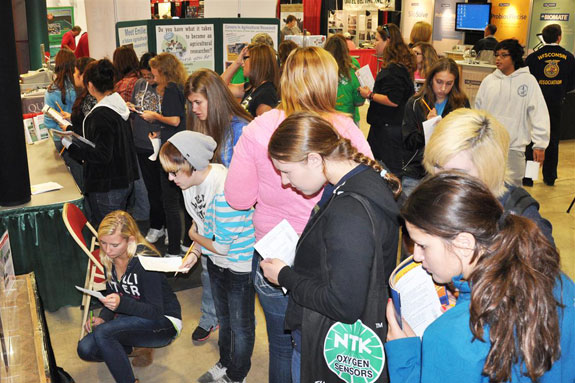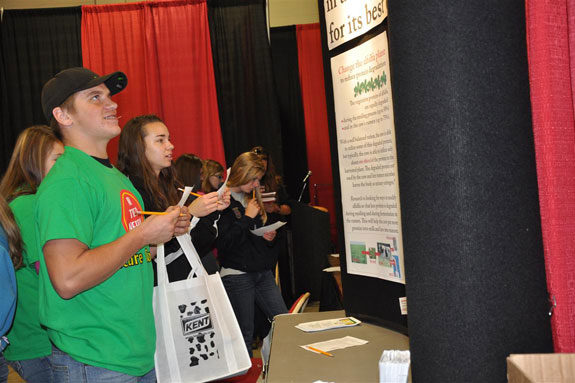They hosted the FFA Dairy Forage Quiz in conjunction with World Dairy Expo 2012 and the World Forage Analysis Superbowl.
The FFA Dairy Forage Quiz brought 650 students to an educational display where they were given a chance to answer questions relating to the dairy and forage industry to win an ice cream cone sponsored by Mycogen Seeds. Wisconsin State FFA officers helped with the event.
How much do you know about the industry? Could you pass the quiz?
Test your knowledge with the questions below (answers are at the bottom of the page, but no cheating!).
Post a comment to tell us how many you got right – we’ll hold a drawing for a Progressive Forage Grower hat from all those who participate (no matter how many you get right) by posting your results as a comment before November 30, 2012.

2012 FFA Dairy Forage Quiz
1. To become a research scientist, what is the highest level of education degree you must have?
a. High school
b. University BA or BS
c. University Masters
d. University PhD
2. The mission of the U.S. Dairy Forage Research Center is:
a. To promote the use of corn silage as a dairy feed
b. To enhance sustainable and competitive dairy forage systems
c. To license new commercial forage varieties
d. All of the above
3. Perennial forages benefit the environment in what way?
a. Reduce soil erosion
b. Reduce surface water runoff
c. Improve soil quality
d. All of the above
4. Ruminants include which of the following animals?
a. Elk, sheep, deer
b. Snakes, lizards, iguanas
c. Horses, pigs, sheep
d. Dogs, cats, cows
5. Which of the following is a grass?
a. Corn
b. Soybeans
c. Clover
d. Cotton
6. Agricultural researchers are employed by:
a. Universities
b. Government agencies
c. Private companies
d. All of the above
7. The U.S. Dairy Forage Research Center has laboratories and research farms in which Wisconsin cities?
a. Green Bay, Wausau and LaCrosse
b. Madison, Prairie du Sac, Marshfield and Stratford
c. Eau Claire, Madison, Oconomowoc and Platteville
d. Madison and Appleton
8. Examples of byproduct feeds that cows eat include:
a. Almond hulls, citrus pulp, brewers grains
b. Corn gluten feed, beet pulp, soybean meal
c. Bakery waster, candy waste, cottonseed
d. All of the above
9. Nutrients such as nitrogen as cycled through a dairy farm in which order?
a. Crop, feed, cow, manure, soil, crop
b. Manure, cow, soil, crop, feed, manure
c. Cow, soil, manure, crop, feed, cow
d. Feed, manure, cow, soil, crop, feed
10. Dairy cows are which type of animal?
a. Microbiotic
b. Ruminant
c. Monogastric
d. Equine
11. Research at the U.S. Dairy Forage Research Center has helped U.S. dairy farmers (combined, as a whole) save more than:
a. $586.210 per year
b. $9.7 million per year
c. $2.8 million per year
d. $1.5 billion per year
12. Forages include:
a. Grasses and legumes
b. Cottonseed and grasses
c. Legumes and soybean meal
d. All of the above
13. Forages help hold soil in place in which way(s)?
a. By providing a 'canopy'
b. With their deep roots
c. By being perennial crops
d. All of the above
14. Feed passes through the four compartments of a cow's stomach in which order?
a. Rumen, stomach, small intestine, large intestine
b. Abomasum, omasum, reticulum, rumen
c. Rumen, reticulum, omasum, abomasum
d. Esophagus, stomach, pancreas, liver
15. What does BMR stand for when referring to corn silage hybrids?
a. Big midrib
b. Brown midrib
c. Better milk results
d. Bovine milk reducer
16. What is the major source of fiber for cows?
a. Corn
b. Soybeans
c. Forages
d. Water
17. Vegetative protein in alfalfa is rapidly degraded in:
a. Upright tower silos
b. Bunker silos
c. The cow's rumen
d. All of the above
18. When was the brown midrib (BMR) gene mutation discovered in corn?
a. 1835
b. 1924
c. 1997
d. 2004
19. The USDA agency "ARS" stands for:
a. Animal Regulatory Standards
b. American Registry of Science
c. Agricultural Recognition Service
d. Agricultural Research Service
20. A dairy cow's diet should not exceed 16-17% protein because:
a. The excess protein is just excreted as urinary protein
b. There are no further increases in milk production when protein is fed at levels greater than this
c. Feeding protein supplements can be expensive
d. All of the above
21. Which is the best definition for nutrients?
a. Vitamins, but not minerals that humans need to live
b. Oxygen and protein that animals need to live
c. The elements in food that the human body can't utilize
d. Elements that all living things need to consume and assimilate in order to live
22. MUN, a measure of feed protein efficiency in cows, stand for:
a. Milk Urea Nitrogen
b. Most Unneccesary Nutrient
c. Milk Utilized Nicely
d. Milk Under Nitrogen
23. What is the most common forage legume fed to dairy cows?
a. Kura clover
b. Timothy
c. Alfalfa
d. Corn
24. Most agricultural researchers:
a. Live in Florida
b. Majored in chemistry
c. Dropped out of high school
d. Like to solve problems and are naturally curious
25. With larger hay bales, spontaneous heating occurs:
a. When the bales break
b. At lower moisture levels when compared to small bales
c. With alfalfa, but not with clovers
d. Only when exposed to rainfall (>6 inches)
Answers: 1. D; 2. B; 3. D; 4. A; 5. A; 6. D; 7. B; 8. D; 9. A; 10. B; 11. D; 12. A; 13. D; 14. C; 15. B; 16. C; 17. D; 18. B; 19. D; 20. D; 21. D; 22. A; 23. C; 24. D; 25. B
PHOTOS
Photos courtesy of Lori Bocher, U.S. Dairy Forage Research Center.











